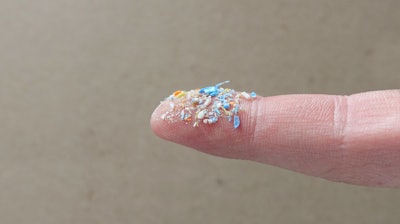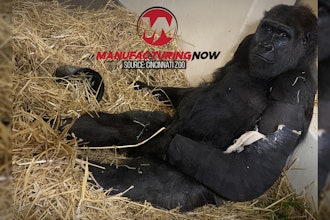
Microplastics dominate headlines as more research reveals that tiny plastic particles contaminating global waterways and the air are in human blood.
Plastics have been in use since they were first developed in the 1950s. Over the last 70 years, a lack of a cohesive global plan to stop the abuse of plastic has been catastrophic to the environment, marine life, and humans.
Microplastic particles are about 5mm in length. They often come from common single-use plastics like bags, bottles, and food packaging. The poisonous polymers they're made of rarely break down completely. What's left are massive amounts of the tiny plastic particles.
Those particles then form huge clumps that clog and pollute waterways, fall through the air and somehow into our bodies.
Where Are Microplastics Now: In the Bloodstream
Dr. Dick Vethaak is a professor emeritus of Ecotoxicology / Water Quality and Health at Vrije Universiteit ( VU) in Amsterdam. His recent findings on microplastics in human blood have gone viral. "…It is certainly disturbing because it shows that people ingest or inhale so many plastic particles that it ends up in the bloodstream. Such particles can cause chronic inflammation and DNA damage."
Vethaak explains, "Now that we have discovered that plastic is in our blood, we need to know what fraction of plastic particles remain in our body, accumulates in certain organs, which fraction is excreted, can plastic particles cross the blood-brain barrier and reach the placenta and the fetus?"
Wait. Why so much emphasis on early-stage development in utero?
"…they are likely to be at greater risk of plastic pollution. They are more susceptible to the adverse effects of both particle pollution and toxic chemicals, such as the numerous plastic additives labeled as hormone-disrupting chemicals," he continues.
Latest Research into Removing Microplastics from H2O
To get the microplastics out of blood, more needs to be done to remove them permanently from water.
A new line of inquiry focuses on using non-toxic chemicals (think plants) to pull microplastics out of the waterways. Cleaning up wastewater requires flocculants which are sticky, toxic chemicals that attract microplastics to help form large clumps. The clumped particles then fall to the bottom of the seafloor or wastewater treatment plant and can be removed from the bottom.
There is research into using non-synthetic materials to replace flocculants with plant-based materials.
Dr. Rajani Srinivasan is an Associate Professor of Chemistry and Department Head of Chemistry, Geosciences, and Physics at Tarleton State University. She has studied food-grade plant extracts as non-toxic flocculants to remove textile-based pollutants from wastewater. "I was working with the removal of microorganisms and things like that, and I thought, ‘Why not try microplastics?'"
In March 2022, she presented her research on natural flocculants at the annual spring meeting of the American Chemical Society. "To remove microplastics from water, it is using food-grade material, not only okra. (It is) to not to add to the more toxic chemicals or contaminants that we have been using."
It's not limited to okra. Other plant-based materials have high polysaccharides extracts, a natural version of the sticky goo that attaches to the microplastics. Polysaccharides found in aloe, psyllium, cactus, tamarind, and fenugreek are just as useful. Mass-produced plant material offers promising results as a safe alternative to cleaning up water.
Srinivasan added, "It will come to us eventually. Food grade is not harmful to us. It will take a while for the world to understand that this does NOT take away from the food that people need to eat to keep from starving. It is sustainable."
Pros & Cons of Using Plant-based, Organic Material to Eradicate Microplastics
However, Srinivasan recognizes the current critique of her research study. She says her research shows growing plant-based products on a mass scale would be good for the global economy by creating jobs in the farming sector.
Dr. Jagdish Khubchandani, Professor of Public Health at New Mexico State University, agrees with the findings of both Dr. Vethaak and Dr. Srinivasan that change must happen to preserve the health of humans and animals.
"This would mean that apart from the plastic control strategies, we also need to work on more distal ends of the exposure (e.g., wastewater treatment and food production with lesser exposures)."
Khubchandani remains skeptical of relying on plant-based technologies. "I fear that we may end up designing synthetic slimy compounds to treat water as okra cannot be used at a mass scale. Every solution we generate may come with a newer problem, but we may have to go with the least problematic solution."
What Happens if Microplastics Keep Building Up in Blood?
Ryan Andrews, RD, a principal nutritionist and adviser at Precision Nutrition, finds the current research to be novel, but he too remains skeptical, "I'm all in favor of using extracts from plants like okra and aloe to help remove microplastics from wastewater. But to me, this seems a bit like rearranging deckchairs on the Titanic."
Andrews prefers a structured approach to educate people about plastic and its effect on humans and aquatic life:
"…This means getting serious about reusable food/beverage containers. Developing deposit schemes to incentivize reuse. Banning certain items, and demanding corporate responsibility…"
While he highlights the bullet points that are part of the global push to control the use of plastics for the long term, there are also real ramifications if human blood begins to show toxic levels from the microplastics.
Robert Mendenhall, part of the Nursing Resource Team at Kootenai Health in Idaho, says the medical costs are not a solution. "The only way to remove things from the bloodstream is at the level of the kidney or the level of the liver, outside of that the only way we have found to remove items from the bloodstream is to enter a filter (Like an IVC filter for a patient with DVT or blood clot) or to do dialysis, remove the blood from the body and filter it through a machine."
Costly medical procedures won't save lives or the planet.
What are Do-Able Next Steps to Mitigate the Negative Outcomes from Microplastics
Dr. Vethaak suggests a global approach, "…A One Health approach. There is only ‘one' health shared by humans. To make this work, we should encourage greater collaboration between public health and animal health sciences, ecotoxicologists/ecologists, and other relevant disciplines and groups."
Dr. Srinivasan sees families as playing a critical role. "They understand about NOT using plastics with their kids, whether baby bottles, diapers, or plastic lunchboxes. And it comes from more awareness and in lay terms. Small kids understand at their language level that plastics are bad. "
If the researchers are to be believed, there can be a "One Health" solution for all.
This post was produced and syndicated by Wealth of Geeks.






















